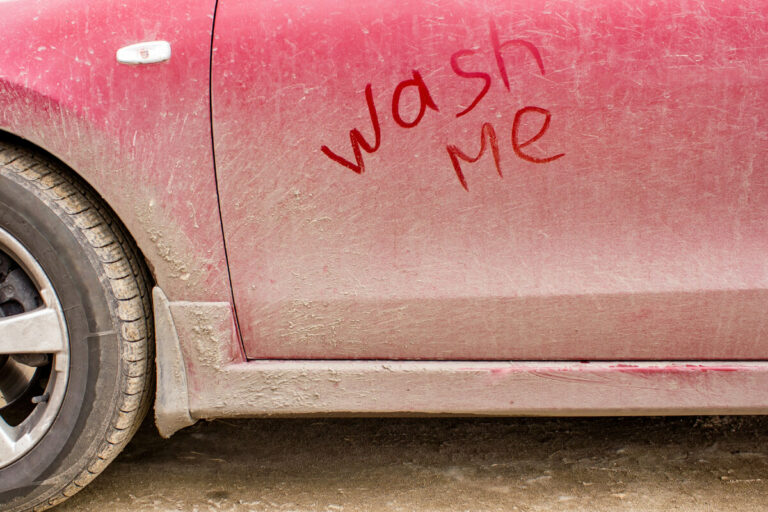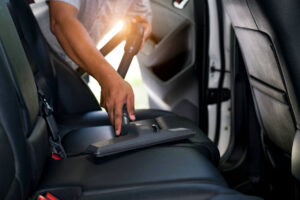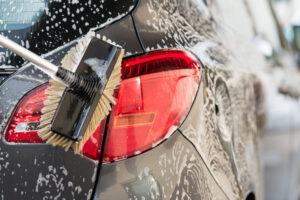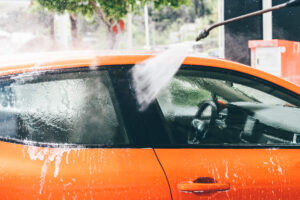For most of us, our car, truck, or SUV is one of our most significant investments. Not only have we made a hefty investment in these vehicles, we rely on them to get to work, get food, transport our family, and live our lives. And our investment doesn’t end when we finish paying for our vehicle. Our vehicles require ongoing investments in the form of oil changes, tune-ups, wiper replacements, tires, brake pads, new batteries, and more. Because you have so much time and money wrapped up in your car or truck, it makes sense to keep it in shape with regular cleaning and washing.


Most vehicle owners will wash their cars when they become visibly dirty. For many people, seeing mud, pollen, dust, or bird excrement can prompt a visit to the car wash. Anyone who drives to the shore (or even near it) may also notice a sticky, saltwater build-up, and get their car washed.
However, other vehicle owners may not notice dust or dirt. These vehicle owners may not wash their cars for weeks or even months. Others are content with allowing rain and wind to act as nature’s car wash and settle for “good enough.”
However, it may be a mistake to rely on visual cues. Your car or truck may need washing even if it doesn’t look dirty. That’s because some of the most harmful contaminants are not easy to spot. Even small traces of dirt or grime can eat away at a vehicle’s finish, fade or chip paint, and eventually allow rust to take hold on the exterior’s metal frame. Keeping a car or truck clean and shiny not only looks great, but it also protects the finish.
And while keeping the exterior clean will protect the metal bodywork, cleaning the interior also makes surfaces look better, reduce wear, and even increase the value of your vehicle. It pays to care for the condition of the interior and exterior surfaces.
Why do Cars and Trucks Need Washing?
With the right care and attention, your vehicle can look great and run well for years, even decades. That’s because cars and trucks are manufactured to last if they are properly maintained and cared for. Car washing is a part of that maintenance routine. The exterior of cars and trucks is well-protected with three rugged layers; a clear coat, a base coat, and a primer.A clear coat makes up the outer shell. This coat is standard for most late model cars and provides a gleaming shine. The clear coat is actually a paint that doesn’t contain any color or pigment. It’s applied to protect the vehicle’s paint job. Some clear coats are made from urethane or polyurethane to give a car or truck a high-gloss, showroom sheen.
While it may seem like a clear coat is enough to protect a vehicle’s paint layer, remember that the clear coat is also paint. That means it can be nicked, chipped, scraped, or scratched. Most clear coat finishes have UV inhibitors in them, but over time, they will fade or oxidize if they are parked in the sun year after year.
The base coat consists of the colored paint on a vehicle. Base coats usually don’t contain strengtheners or hardeners. The clear coat is the protector. If you find nicks or scratches in the clear coat, then water and contaminants can reach the base coat. When that happens, you may start to see blemishes or discoloration in the paint. Over time, moisture or contaminants will eat through the paint and start working on the metal frame.
The base coat is usually applied on top of a primer coat. While the primer coat often help protects the metal from rust, usually it is not a rust-prohibitor. This coat is applied to the surface of the metal to help paint stick to the vehicle. The primer is primarily a binding layer, not a protectant.
When all layers are intact, your car is built to resist decades of wear and weather. However, dirt, acids, and fine particles wear away at the surface of any vehicle. Even fine bits of grit can start scratching a clear coat, compromising the layers underneath.
No matter where you live or what you drive on, your car is subjected to dirt, grit, grime, bugs, and bird dropping. No matter where you travel, rustic dirt roads or pristine highways, you expose your vehicle to some amount of dust and dirt.
Everyday dust is the most common issue. For people who drive in arid weather, such as desert climates in Arizona or New Mexico, the dust is too dry to cling to a car’s exterior for long. However, in damp climates in the Mid-Atlantic states such as Pennsylvania, moisture in the air allows particulates to cling to the vehicle. When moisture interacts with dust that has settled on the finish, it becomes sticky and creates a slight film. Even a simple dust film will slowly deteriorate your vehicle’s paint finish.
Some drivers think that the wind will blow off this kind of dirt. Instead, wind compounds the issue. Whether it is a windy day, or the wind is simply generated by a moving vehicle, this kind of moving air pushes the slightly damp dirt over your car’s surface in ways that create tiny scratches in the clear coat. Over time, even these small scratches compromise the protection of the clear coat.
But everyday dirt and dust are not the only problems. It doesn’t matter if you live in the city or the country; your car or truck is exposed to different types of dirt and grime every time you drive it. Your vehicle’s exterior comes into contact with exhaust from traffic, dust from construction, chemicals from agriculture and industry, and even fine rubber dust from tires. These substances are even stickier than ordinary dust, so they will cling to your car’s exterior, even if additional moisture is not present. And because these bits are usually bigger than dirt or dust particles, when the wind moves them even a little, they can scratch your car’s surface.
Another set of hazards for your vehicle’s paint job come from the air. Bird droppings are not only unsightly, they are also highly acidic. If left on a car for too long, they can etch into the clear coat, and eventually into the paint. Bug splats are harder to spot, but they’re also sticky and acidic. Because bug splats are most common on headlights and grills, many car owners are aware that they can scratch those surfaces, but the acid from a decaying bug can also eat into the body of your vehicle. To protect your car’s exterior, you should remove bird droppings or bug splats as soon as you spot them.
Salt is another enemy of car paint and clear coats. All types of salt are corrosive substances and can accelerate rust formation on metal surfaces. If your vehicle’s clear and paint protection layers are not intact, most cars exposed to winter de-icing salt start rusting in a few months. A clear coat can stop the salt from attaching to the metal. However, over time, road salt will work its way through the clear coat, so the faster you can remove it, the better.
Here’s a video on how salt can damage your car
While road salt can be a hazard for your car or truck, sea salt is worse. In fact, sea air containing saltwater can corrode metal ten times faster than average humidity.
According to Sciencing,
“Current flows more easily in saltwater than it does in freshwater. This is because saltwater, an electrolyte solution, contains more dissolved ions than freshwater, meaning electrons can move more easily….Saltwater corrodes metal five times faster than fresh water does, and the salty, humid ocean air causes metal to corrode 10 times faster than air with normal humidity.”
Finally, even the trees around you can present a challenge to your car’s surfaces over time. The sap and pollen from trees can become corrosive if they are left on your vehicle for long periods of time.
Whether it’s dirt, pollutants, organic matter, or salt, once these surfaces attach to your car, they begin to trap moisture. The moisture and grime are in continual contact with the clear coat, resulting in scratches, deterioration, or even dissolving.
Once the top, clear coat is damaged, additional moisture and dirt can seep onto the paint layer. As the clear coat is worn, scratched, or even eliminated, the paint becomes more and more vulnerable. In fact, once a clear coat is compromised, even people brushing up against your car can scratch and damage the paint.
When the clear coat is damaged, you may start to see chips, flakes, or bubbles in the paint, most often near or on the doors or windows. These are caused by rusting metal underneath, pushing the paint up. While you may think this process takes a long time, it can actually happen very quickly. As mentioned, people living near or regularly visiting saltwater are at the highest risk for quick-spreading rust.
How Often Should I Wash My Car?
By now, you know how important it is to keep your car clean. When determining how often to visit a car wash, the first consideration is usage. People who use their vehicles more will need to wash it more. People who use their vehicles infrequently and keep them in covered parking like a garage or covered parking lot may not need to visit car washes as often.
Visit a Car Wash Twice a Month
Most commonly, people need to wash their vehicles every other week. Drivers who use their car daily, and often park it outside their home or in an uncovered parking lot, should plan to wash their vehicle a few times a month. Rinsing off the dirt and grime of everyday urban or suburban driving, with particular attention to undercarriages if it’s exposed to salt, will help keep your car’s exterior in good condition for years and years.
Visit a Car Wash Weekly
While many people can protect their vehicle with a few car washes a month, other drivers should invest in weekly washing. Drivers who live in rural areas, near tilled fields, drive past industrial areas, travel on dirt roads, commute close to construction, or who visit the shore regularly should wash their vehicles every week.

Additionally, people who live in an area with a lot of bugs and flying insects, visit wild areas or forests, park near or under sappy or pollen trees, or live in a no-spray area may also need to visit a car wash weekly. To ensure you remove stubborn bugs, sap spots, or salt stains after each wash check the vehicle and clean off any remaining spots with hot water and a soft cloth. A mild solvent created for auto care may be necessary for stubborn spot cleanings. And don’t forget to pay special attention to removing bugs from grills and headlights.
Get a Car Wash ASAP
If you are driving on salted roads or staying at the shore, you may want to get your car or truck washed more than once a week. To protect all parts of your vehicle from a build-up of corrosive road salt, be sure to get periodic undercarriage treatments.People who often visit the shore or beach should invest in high-quality wax jobs to give their vehicles an extra layer of protection against the salt in the air. Undercarriage treatments are also a smart way to protect every part of your car or truck from saltwater damage.
Once a Month Car Wash
Not everyone has to wash their vehicle frequently. People who use their vehicles occasionally, don’t expose them to sea salt or road salt, don’t park near sappy trees, encounter few bugs, or keep their vehicles parked in a garage may be able to get away with monthly car washes.
Clean Your Vehicle’s Interior Often
While the environment is a significant factor in the frequency of car washes, the way you treat your car’s interior will determine how often to clean it. People who have kids, dogs, or eat and drink in their vehicle should clean the interior frequently.In light of the health concerns during the recent pandemic, some experts are suggesting even more rigorous techniques for interior cleaning. According to Janet Loehrke and Veronica Bravo in USA TODAY,
“Chances are you already have the cleaning supplies you need to clean your vehicle, and luckily it’s not too complicated…Soap, water and alcohol solutions such as disinfectant wipes that contain at least 70% isopropyl alcohol are the most effective household products to kill the coronavirus according to the Centers for Disease Control and Prevention. Just like washing your hands for 20 seconds, that applies to your car’s interior surfaces too. Any product will need a few more seconds to breakdown the virus, so take your time before you wipe it clean. Most imitation leather and leather seats have a protective urethane coating, so using alcohol-based products can lead to damage if used too often.”For more everyday cleaning needs, there are three basic rules to remember;
- Clean frequently
- Use gentle cleaners
- Use cleaners formulated for auto care whenever possible
Cleaning often allows you to get rid of dirt and grime before it settles in and damages a surface. Two or three times a month, gently run a vacuum hose over seats and carpet to remove surface dirt and debris. Look for stains as you vacuum and use an upholstery spot cleaner to remove them. Vacuums offered at car washes are purpose-built for auto interiors. These inexpensive, coin-operated vacuums offer both high suction and specially-shaped nozzles to do the job right.
When it comes to seating, error on the side of gentle cleaning, and use cleaners formulated for the surfaces in your vehicle. While most vinyl seats can be wiped down with a damp cloth, using an auto store cleaner may help reduce fading or cracking.
If your car or truck features leather seats, it’s even more important to use a cleaner and conditioner made for that purpose. The wrong cleaner can damage the surface, fade the color, or even cause cracking. For best results, use specially-formulated automotive leather conditioners on your leather seats every other month.
Wipe your dashboard, steering wheel, compartments, and doors with a damp cloth. Make sure glass and mirrors are smudge-free. And because commercial glass cleaners can damage the UV coating on auto glass, stick to using glass cleaners formulated for automotive use.
According to Consumer Reports, paying extra attention to your vehicle’s interior is a sure-fire way to boost your car’s resale value. Here are some of their top interior cleaning tips.
“Clear the cup holders. These are probably the dirtiest spots in your car. To clean them fast, put an old sock over the bottom of a travel cup, spray it with window cleaner, and twist. Then get into the corners with a wooden barbecue skewer and pick out any remaining crud; remove it with a microfiber cloth. To make cup holders easier to clean, invest in rubber liners that you can take out and rinse. You can buy them at dealerships, car washes, and auto-parts stores for as little as $6.
Blast out crevice dirt. Poke around a car’s nooks and crannies, and you’ll probably find pens, change, keys, mud, and other odds and ends. After grabbing the big stuff with your hands, use a barbecue skewer to pick out the debris wedged between sill lips and carpeting. Then vacuum the area using the cleaner’s crevice tool (the attachment that’s flat at the end). Finish off the area with glass cleaner and a microfiber cloth.
Get into corners. You don’t need special tools to clean out tight interior areas. Wood skewers and cotton swabs are great for small spots such as vents, seams, buttons, and switches. Old makeup brushes also work well in louvers and vents.
Deep-clean fabrics. Spray vacuumed carpets (and cloth seats if you have them) lightly with a foaming aerosol cleaner. After it begins to dry, use a vacuum to remove it. For an even deeper cleaning, rent a carpet extractor from a home center or grocery store.
Be gentle with plastics. Use an ammonia-free glass cleaner on plastic surfaces. (Ammonia may cause surfaces to bleach.)”
When Should You Wax Your Vehicle?
As discussed earlier, cars and trucks have three layers of protection – a clear coat, paint, and metal. However, you can add a fourth layer of protection – car wax. Waxing not only keeps your car shiny, but it also repels water and protects your clear coat from all the things we’ve discussed in this article; dirt, sap, bugs, bird droppings, pollution, and salt.Wax does more than make your vehicle shiny and pretty. It also helps corrosive substances we’ve discussed slide right off your paint. Auto wax provides an extra layer of protection between the offending dirt and gunk and the paint job.
How do you know if your car needs waxing? If you splash a bit of water on your car and it doesn’t bead up, it’s time to renew your wax job. As a rule of thumb, plan to give your vehicle a thorough waxing at least twice a year.
Make the Most of Every Car Wash
Keeping your car clean and looking great is important for many reasons. A clean vehicle reflects well on you, but it also keeps your ride running better, longer. A good maintenance program will help increase the resell value.Regular car washes are also the perfect excuse to inspect parts of your car or truck and touch up areas that need a little more TLC. Here’s a guide to help you make the most of every car wash.
Before you visit the car wash, complete a visual inspection
At least once a week, take the time to walk around your vehicle and do a full visual inspection of your car. How is the wax job holding up? Does it have bug or sap spots? Are there any new scratches or dings? Is the interior faded or damaged?
In addition to looking for issues with the exterior, look at the interior of your vehicle. Is the carpet or flooring clean? Are the seats wiped down? Are there smears or smudges on the surfaces?Make Regular Visits to the Car Wash
A drive-through, automatic car wash is an easy way to keep your car cleaner, longer. A visit to your local Sundance Car Wash will keep the outside of your car looking great. Sundance uses special automotive grade cleaners that won’t scratch or damage your vehicle. Best of all, the drive-through allows you to stay clean and dry in any weather.
However, if you have problem areas, you may want to use a hand wash bay. A hand wash bay is a good idea if you have heavy dirt, sap or bugs that need extra attention to remove.
When you choose a hand wash bay, take time to thoroughly rinse off all the soap, especially on hot days when it’s easy for soap to dry quickly on your vehicle.Take Time to Vacuum
After you’ve cleaned the outside of your car or truck, take 15 minutes to clean the inside. Sundance offers vacuums designed to get into tight spaces in your vehicle. They’re also much more powerful and more flexible than home vacuums.
When you’re vacuuming, look for food, change, or debris in crevices. Spend a little extra time to clean those small spaces. Remove any paper or trash at this time.
To get into every crack and crevice, move the front seats all the way forward, and then all the way back so you can vacuum underneath the seats. Don’t forget to vacuum up crumbs and debris from seat and door pockets.Wax Your Car
An extra coat of wax can defend your car or truck from UV rays, salt, dirt, pollen, snow, bird droppings, and bug splats. When you visit Sundance, you can choose a protective wax or clear coat protectant to be applied as part of your car wash. This will help your paint shine and repel dirt until your next car wash.Remove Any Spots and Clean the Interior Windows
Once you’ve completed your car wash, take a dry towel, and spot check your windows. Remove any droplets and make sure you’ve wiped off any extra moisture before hitting the road.
This is also a good time to wipe down your interior windows using an automotive window cleaner. While auto window cleaning products are usually a little more expensive than household glass cleaners, they don’t contain ammonia. They are made to work without damaging the special coatings applied to many types of automotive windows.Look for Small Scratches
Once you have a clean, dry surface, it’s a good time to look for scratches, nicks, or other surface issues. Small issues can be handled with automotive products, but bigger scratches may require professional treatment.
Any time you use a scratch-removing product on your vehicle, you will also remove the wax finish. It may make sense to get your car or truck waxed after fixing small scratches.
Scrapes or larger scratches may require the help of a professional. While it may cost a bit short-term, it will protect your vehicle from damage over the long run.Freshen up the Smell
Like it or not, if people ride in your car, they bring along smells. Some scents are carried on clothes, while others develop when food, pets, or smoke are in the vehicle. Whenever you clean your car, check for odors. While some in-car deodorizers may be able to handle mild smells, if you regularly bring food, pets, or smelly clothes into your vehicle, you may acquire a funky smell over time that is hard to cover. Smokers and vapers face even more substantial odor challenges.
Frequent interior cleaning can help mitigate smells. Airing out your vehicle, such as leaving windows open overnight, is also helpful if you park in a garage.
Of course, the most effective method to reduce smells is to stop introducing them. Ban fried food from your vehicle. Don’t store gym shoes in your back seat. Stop smoking or vaping in your car. Lingering smells are not only unpleasant, but they can also reduce your ride’s resell value.
Sundance offers a variety of air fresheners and deodorizers to keep your ride smelling fresh!


Let’s Review. Best Car Wash and Cleaning Tips.
To sum it up, many factors affect how often car washes are needed, including:- LOCATION = Where you live, work, and drive will impact your car’s condition. Whether you park your car at home or at a covered garage near work also affects the cleanliness of your car’s exterior. If you drive near a construction site, tilled fields, industrial areas, oceans, near sap trees, near pollen-producing trees, on salted roads, or on roads with lots of bugs and birds, wash your car or truck more frequently.
- HOW FAR YOU DRIVE = The more you drive, the more you need to wash your car.
- WINTER WEATHER = Road salt corrodes your undercarriage. If you’re driving on salted roads, wash your car or truck weekly, and treat your undercarriage.
- SEA SALT = Even if you just visit the shore for a day, or drive to locations near the beach, sea salt builds up on your car or truck. Ocean visitors should wash their vehicles weekly.
- HOW YOU TREAT THE INSIDE OF YOUR VEHICLE = While some people are very careful to keep their interiors clean, some cars and trucks get messy. Don’t forget to vacuum and wipe down your vehicle’s interior.
Special cleaning may be necessary for interiors if you are trying to prevent the spread of viruses. For all others, automotive interiors should be cleaned frequently, gently, and with appropriate automotive cleaners.
While your vehicle is manufactured with three layers of protection, waxing may offer another layer of defense. And if you see any scratches or nicks on your cars clear coat or paint coat, get it repaired as soon as possible to prevent rust build-up.
And finally, take advantage of all the great Sundance Car Washes in your area. We’re here to help your car, truck, or SUV look better, and live longer!





